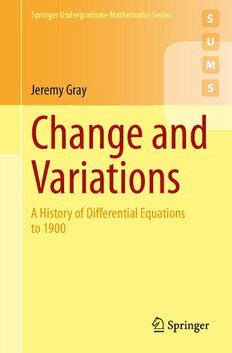
Change and Variations: A History of Differential Equations to 1900 PDF
Preview Change and Variations: A History of Differential Equations to 1900
Springer Undergraduate Mathematics Series Jeremy Gray Change and Variations A History of Differential Equations to 1900 Springer Undergraduate Mathematics Series AdvisoryEditors MarkA.J.Chaplain,St.Andrews,UK AngusMacintyre,Edinburgh,UK SimonScott,London,UK NicoleSnashall,Leicester,UK EndreSüli,Oxford,UK MichaelR.Tehranchi,Cambridge,UK JohnF.Toland,Bath,UK The Springer Undergraduate Mathematics Series (SUMS) is a series designed for undergraduatesinmathematicsandthesciencesworldwide.Fromcorefoundational material to final year topics, SUMS books take a fresh and modern approach. Textual explanations are supported by a wealth of examples, problems and fully-workedsolutions,withparticularattentionpaidtouniversalareasofdifficulty. Thesepracticalandconcisetextsaredesignedforaone-ortwo-semestercoursebut theself-studyapproachmakesthemidealforindependentuse. Moreinformationaboutthisseriesathttp://www.springer.com/series/3423 Jeremy Gray Change and Variations A History of Differential Equations to 1900 JeremyGray SchoolofMathematicsandStatistics OpenUniversity MiltonKeynes,UK ISSN1615-2085 ISSN2197-4144 (electronic) SpringerUndergraduateMathematicsSeries ISBN978-3-030-70574-9 ISBN978-3-030-70575-6 (eBook) https://doi.org/10.1007/978-3-030-70575-6 MathematicsSubjectClassification:01A50,01A55,01A60,34-03,35-03 ©TheEditor(s)(ifapplicable)andTheAuthor(s),underexclusivelicensetoSpringerNature SwitzerlandAG2021 Thisworkissubjecttocopyright.AllrightsaresolelyandexclusivelylicensedbythePublisher,whether thewholeorpartofthematerialisconcerned,specificallytherightsoftranslation,reprinting,reuse ofillustrations,recitation,broadcasting,reproductiononmicrofilmsorinanyotherphysicalway,and transmissionorinformationstorageandretrieval,electronicadaptation,computersoftware,orbysimilar ordissimilarmethodologynowknownorhereafterdeveloped. Theuseofgeneraldescriptivenames,registerednames,trademarks,servicemarks,etc.inthispublication doesnotimply,evenintheabsenceofaspecificstatement,thatsuchnamesareexemptfromtherelevant protectivelawsandregulationsandthereforefreeforgeneraluse. Thepublisher,theauthorsandtheeditorsaresafetoassumethattheadviceandinformationinthisbook arebelievedtobetrueandaccurateatthedateofpublication.Neitherthepublishernortheauthorsor theeditorsgiveawarranty,expressedorimplied,withrespecttothematerialcontainedhereinorforany errorsoromissionsthatmayhavebeenmade.Thepublisherremainsneutralwithregardtojurisdictional claimsinpublishedmapsandinstitutionalaffiliations. ThisSpringerimprintispublishedbytheregisteredcompanySpringerNatureSwitzerlandAG Theregisteredcompanyaddressis:Gewerbestrasse11,6330Cham,Switzerland Preface TheShapeoftheBook Thisisabookonthehistoryofmathematics;itsbasicdynamicishistoricalandthere- fore,uptoapoint,chronological.Itfollowstheprogressofanumberofideasthat grew,sometimescametogether,andoftendevelopedrichandfascinatingbranches and applications. At its core is an account of how the calculus of Newton and Leibniz—thecalculusoffunctionsofasinglevariable—ledtoattemptstodevelopa calculusoffunctionsofseveralvariableandhowthesenewmathematicalmethods contributedtothestudy,firstofordinary,andthenofpartialdifferentialequations. Ineachcase,therationaleforthatworkwaschieflytodevelopgeneralmethodsthat couldtackleproblemsingeometryandmechanics(themotionsofsolidsandliquids undertheactionofforces). Thephysicalworldbeingacomplicatedplace,mostoftheapplicationsinvolved partialdifferentialequations,andherethestorysoonalsobecamecomplicated.The first-orderpartialdifferentialequationintwoindependentvariableswasinitiallydiffi- culttosolve,andthisposedproblemsforthestudyofmorethantwoindependent variables and for equations of higher order. Important work on the first-order case wasdonebyLagrangeandMongebeforeCauchywasfinallyabletoshowthatsuch equationsalmostalwayshaveasolution.Butthesecond-ordercasealmostimmedi- atelyconfineditselftothreespecialcases,somewhatasEulerhadsuggested,andall ofthem,aswewouldsay,linear.Thefirst,andsimplest,isthewaveequation(the prototypehyperbolicequation),successfullytackledbyd’Alembert.Eulerregarded theonelaterknownastheellipticcase(thekeyexamplebeingtheLaplaceequation) asbeingbeyondcurrentmethods.Finally,thecasewecallparabolicfellthrougha gapinhisapproach,andstrangelylittlewassaidaboutitbeforeFourierdealtwith thecanonicalexample:theheatequation.Atthispoint,asignificantdeparturefrom thetheoryofordinarydifferentialequationsopenedup:theneedtopayattentionto initialorboundaryconditions.However,thisissuewastoremainobscureforseveral decades. v vi Preface Euler quickly showed that linear ordinary differential equations with constant coefficientscanbesolvedsystematically.Othertypesofordinarydifferentialequa- tionswerestudiedintheeighteenthcentury,butthestoryispiecemeal,andinstead, Ichosetogivejustoneexampleofthehistoryofordinarydifferentialequations:the hypergeometric equation from Gauss to Riemann, Schwarz, and Poincaré. This is one of the glories of the subject, bringing together early ideas about group theory, complexfunctiontheory,andthethen-novelhyperbolicornon-Euclideangeometry. Sohowisallthismaterialorganisedinthisbook?Chapter1connectsthecalculus toproblemsinordinarydifferentialequationsandismirroredbyChaps.3and5in whichthecalculusofseveralvariablesisdevelopedandthefirstpartialdifferential equationsarestudied.Thenitisafairlystraightrunthroughtopicsinpartialdifferen- tialequationtheoryinChaps.6,8,10,13,17–20.Thisallowsustoseehowthework ofEuler,d’Alembert,andafewothersrewroteNewton’sPrincipiaMathematicafor theeighteenth–twentiethcenturies.Thestoryofthehypergeometricequationoccu- piesChaps.11and14–16becauseitmuststartin1812withGaussandbecauseonce itgetsgoingitseemsridiculoustobreakitup.WhatinterveneshereisChap.12on Cauchy’sdemonstrationoftheexistenceofsolutionstoordinarydifferentialequa- tions and Chap. 13 on Riemann’s geometric version of complex function theory, whichisneededforthesubsequentthreechapters. What of the chapters not yet referred to? Chapter 2 describes the start of the calculus of variations, and Chap. 7 takes that subject further into the eighteenth century.Chapter4documentsothersuccessesofthepartialdifferentialcalculusin studyingnaturalphenomenaotherthanthewaveequation.(Thereisalsoasurprising linktothehypergeometricequation.)Chapters9and21areopportunitiesforrevision; whenIgavethecourseIusedtheselecturestodiscusstheassessmentonthecourse sofar. Theremainingchaptersmoveintowhatmaybelessfamiliarmaterial.Riemann’s studyof shock waves; Riemann and Weierstrasson minimalsurfaces;the workof ThomsonandStokesonthetelegraphist’sequationandthelayingofthetrans-Atlantic cable;alookatthefirstninieteenth-centuryattemptstorigorisethecalculusofvari- ations;theeventualintroductionofthefundamentaltrichotomy(elliptic,parabolic, hyperbolic)forsecond-orderlinearpartialdifferentialequationsandthefirstgeneral existencetheoremsintheellipticandhyperboliccasesincludingHadamard’sinsis- tenceofthedistinctionbetweeninitialandboundaryvalueproblems.Twochapters look at how Jacobi used Hamilton’s ideas to create Hamilton-Jacobi theory and subsequentattemptstogeometrisemechanics,andtheconnectiontothesolutionof first-orderpartialdifferentialequations. Allthismaterialhasacertaincoherencethatisworthspellingout.Ordinarydiffer- entialequationsgrewoutof,oralongside,problemsinevaluatingintegrals,whichis whywestilltalk,confusingly,ofintegratingadifferentialequationanditssolutions as its integrals. It was soon recognised that the solution to an ordinary differential equation was a family of functions and an individual solution could be specified bymeansofsomeinitialconditions.So,itwasnaturalwhendifferentialequations with several independent variables were investigated that the earliest researchers (JeanleRondd’Alembert,LeonhardEuler,PierreSimonLaplace,andJoseph-Louis Preface vii Lagrange)thoughtofthesepartialdifferentialequationsinthesameway,andlooked fortechniquesthatwouldproduceaformulaforthegeneralsolution(however,they seldom also discussed an auxiliary process of fitting the general solution to some initialconditions).Partofthestoryhereisthegradualrecognitionthatthisisnotthe rightwaytothinkofpartialdifferentialequations.Rather,itisadialoguebetween thegeneralmethodsandtheinitialorboundaryconditionsthatiscentral,andwhich underpinsthecrucialdistinctionbetweentheellipticandhyperbolictypestowhich formalmethodsareblind.Asweshallsee,thisexplainstheproblematicwayinwhich complexvariableswerefirstused. Itisalsointerestingtoseehowquestionsofrigourenterthestoryinawaythat is immediately important and does not appear as the whim of an analytic pedant. The ad hoc methods that can be used to solve a partial differential equation (such astheseparationofvariables)naturallyraisethequestionoftheuniquenessofthe solutions that is important in applications. The need for power series to converge forcesaheavyrelianceon(realorcomplex)analyticmethodsthathas,ultimately,to beoutflanked. AdvicetoStudents Thereareseveralimportantthingsbeingdescribedinthiscourse,anditmayhelpto rememberwhattheyarebeforeimmersingyourselfinthetechnicaldetails.Newton’s workisacaseinpoint.Eventhoughweshallonlyskimitssurface,itisclearthat this is a remarkable achievement, one that it took more than a century to confirm, and some of the best work of the twentieth century to surpass. Newton’s account of the motion of the Moon and the planets does not rest on the calculus, still less differentialequations,buteveryoneafterhimturnedtothecalculus,andEulergave everyonethemeanstowritecelestialmechanicsthatwayeverafter.Mathematical accountsoffundamentalphysicalprocesses—gravity,theproductionandspreadof sound,thepropagationofheatandofelectricsignals—areamongthesuccessesof thetheoryofpartialdifferentialequations. Butforthecalculustodothiswork,mathematicianshavetohavetheconfidence thatitdoeswork.Thisispartlyamatterofrigour,andindeeditissatisfyingtosee that so many of the questions that are dealt with in courses on pure analysis arose incontextswhereapractical,oratleastaphysical,answerdependedonthequality ofthereasoning.Lessobviously,butperhapsmoreinterestingly,itisworthseeing whateventhebestmathematiciansdidwithdifficultproblems.Argumentshaveto berigorous—ultimately.Beforethentheyhavetobesomeorallofconvincing,intel- ligible,general,plausible,andapplicable.Likewise,solutionshavetobeanumber ofthingsapart,ideally,frombeingright:amongthecriteriaare,ononeoccasionor another,computable,accurateenough,intelligible,complete,andunique.Justasan argumentmightgettotheheartofaproblemorsomehowmerelywork,asolution canbetrulyinformativeormerelyaformula.Allofthisisondisplayhere.And,of course,sometimesanequationwithnoanswerinsightcanstillseemtobeavaluable advance. viii Preface In this sense, the most momentous event on display here in the first half of the courseisthatthecalculus,intheformofdifferentialequations,bothordinaryand partial,candeliversomuchinsight.Thecomparablechangeinthesecondhalfofthe course,asIhintedabove,isthetransformationinwhatasolutionistakentobe.For partialdifferentialequationsthisistherisetoequalimportancewiththeequationof theboundaryorinitialconditions,coupledasitiswithaprofoundclassificationof theseequationsintotypes.Theneedforrigourplayeditspartinthesedevelopments when appeals to the so-called generality of analysis and its supposed algebraic or formalbasisbegantofail. Thisisnotasetoflecturesinwhichepsilonsanddeltas,nsandNsdanceevermore intricately,butthisshouldnotsuggestthatwhenmathematicsisapplied—whatever thatmightmean—standardsdrop.Mathematiciansweredoingtheirbestatalltimes to get it right, although we can observe different ways in which they honoured thatcommandment.Thedifficultmathematicsherecomesfromthedifficultyofthe problems:apartialdifferentialequationisadifficultthingtounderstand,harderthan anordinarydifferentialequation,andharderthanmanyanearlyinvestigatorrealised. Qualitativeargumentsareoftenharderthanquantitativeones,iflesstechnical. Thechallengeyoufaceistogetasenseofthatstruggle,ofthedifficulty,andhow itwastackled. Being a historian of mathematics means attending to mathematics on its own termsaswellasours,andseeingitinthecontextofitstime.Whatwasknown,what wasthoughttobetrue?Whenamathematiciantacklesaproblem,youask:Howhad otherproblemslikethisonebeentackled,howweretheytackledafterthisone?Is theanalysisoftheproblemconvincing,isthesolutioninformative?What,intheend, werethesepeopletryingtodo? HistoriographicalRemarks There are several existing accounts of the history of calculus, and a number of specialistbooksandarticlesonparticularaspectsofthathistory.Thecontributions of Newton and Leibniz, Euler, Lagrange, Fourier, Cauchy, Riemann, Weierstrass, Poincaré,andHadamardhavebeenstudiedinsomedepth;varioustopics,suchasthe waveequation,theheatequation,Laplace’sequation,andtheDirichletproblemhave beenlookedatinsomedetail,althoughnotalwaysaftertheoriginalbreakthroughs were made. But there is no general history of differential equations, ordinary or partial.Historiesofthecalculusdwellonthestoryoftherigorisationofthecalculus and the creation of modern (or, rather, nineteenth century) mathematical analysis, but tend to marginalise the story of what made the calculus valuable: the capacity it gives mathematicians and scientists to formulate and solve problems across the fieldsofphysicsandgeometry.Historianshavetendedtoforgetthatwhatmadethe calculus worth all the efforts to understand it was not ideas about infinitesimals, differentials,limits,andthelikethatwereintroducedtoexplainandjustifyit,butits manysuccessesinprovidinganunderstandingofthenaturalworld,fromthemotion Preface ix oftheplanetstothetransmissionofelectricsignals,andinextendingthepowersof geometry. There have been a few notable departures from this scholarly regime in recent years.CraigFraserandJesperLützenhavesteadilyenrichedourunderstanding,and otherhistorians(TomArchibald,JuneBarrow-Green,UmbertoBottazzini,Christian Gilain,andTomHawkins,amongthem)havedealtwithvariousaspectsofthedevel- opment of the theory of differential equations as it entered into the larger pictures theywereexploring. WhatThisBookisNot ThelargestomissionistheworkofMaxwellandtheequationsnamedafterhim,but itseemedtomethatthemoderntheory,andthephysicalexperimentsthatitexplains, are largely unknown to mathematics students and would have entailed too great a detourtobringtolife.Inaddition,Maxwell’sideasaboutthephysicsinvolvedare notthemodernones—andfamously,noContinentalphysicistclaimedtounderstand them—soitwouldhavebeenimpossibletodothemjusticeinthespaceavailable. DisappointedreadersshouldconsultBuchwald’sFromMaxwelltoMicrophysics.For muchthesamereasons,IwasunabletodealwithhydrodynamicsandtheNavier– Stokesequations,butreadersmayalwaysturntoDarrigol’sWorldsofFlow. Another topic that is wholly missing is the use of perturbative methods. Most differential equations, and systems of such equations, that arose in practice could only be tackled by the method of undetermined coefficients. The idea was to start from a simplified version of the problem at hand that, however, admitted an exact solution, and to seek the solution to the solution to the actual problem by adding more terms to cope with the increased complexity. These might take the form of powerseries,orlatertrigonometricseries,whichwerefittedtowhatdatatherewas, especially in the important subject of astronomy, and their coefficients adjusted to refinepredictionsandexplainothereffects. AnotherimportanttopicthatitwouldbegoodtohaveincludedisSturm-Liouville theory,butthereisalreadyanexcellenthistoricalaccountinLützen’sJosephLiouville (1809–1882):MasterofPureandAppliedMathematics,andIthoughtitbettertoadd tothestockofhistoricalinformationaboutthedevelopmentofdifferentialequations. IwouldverymuchhavelikedtohaveconcludedthecoursewithPoincaré’sideas aboutflowsonsurfaces,andhisbrilliantextensionofthesetechniquesinhisfamous memoironthethree-bodyproblem,whichwouldhavemadeanattractiveconnection backtoNewton’sPrincipiaMathematica,buttheresimplywasnoroom.However, thereareexistingaccountsofthissubject.1 And,Iadmit,thewishtotrytosaysomethingaboutthehistoryofpartialdiffer- entialequations,surelythelargestomissioninthehistoryofmodernmathematics, alsoplayedapartinmydecisionsaboutwhattoinclude. 1Seemostinformatively(Barrow-Green1997),andalso(Gray2013),and(Verhulst2012).
